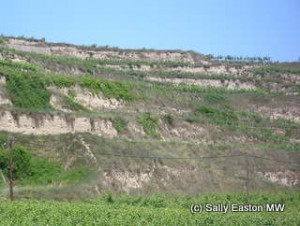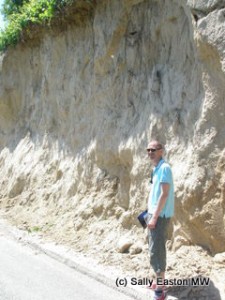Loess is more for grüner veltliner

Loess terraces
In Lower Austria there is a divide between riesling and grüner veltliner which keeps riesling on primary rock and grüner veltliner on loess. Loess, it seems does remarkable things to grüner veltliner – the wines are creamier, fatter, richer, and more immediately fruity in youth.
To get momentarily technical, loess (known as limon in French) is a usually light coloured, unstratified, windblown deposit comprising silt and clay sized particles, often including calcium carbonate. It is formed when particle-laden winds deposit their load, either due to a drop in wind speed or an increase in precipitation. Over millennia it takes on dense landform proportions as depths can reach 100 metres.
The deepest and most extensive loess landform in the world is in north China, which is derived from the deserts of Mongolia, transported by north-westerly winds.
In terms of viticulture, the largest loess landforms are those around Kaiserstuhl in Germany and those further east on a similar latitude in Lower Austria. These form part of a discontinuous belt of periglacial loess stretching from the Ukraine to southern Britain, formed from wind-blown deposits of the Pleistocene epoch Scandinavian ice sheets.
This discontinuous band of loess carries on through much of Lower Austria. While remnants of loess cover some vineyards in Wachau, such as Hochrain and Kollmutz, Kremstal includes in its varied geology a six kilometre loess terrace stretching east from Krems to Gedersdorf. A loess band extends through Langenlois in Kamptal, and further east again, Wagram has about 1,000 hectares, some 40% of its area’s vines, on deep loess terraces.

Deep loess
Effectively in Lower Austria, said Fritz Miesbauer, the winemaker at Stift Göttweig there are “two soils: primary rock – granite, gneiss, schist, which is mostly in the west, and loess in the east.” Primary rock is stony, with a low water supply. Loess is a richer rock, with deep soil and retains more water than primary rock so better meets the demands of thirstier and hungrier grüner veltliner.
Markus Huber of Weingut Markus Huber explained “gruner veltliner is grown on lower lands and foothills, and riesling on terraces, because grüner veltliner has a higher water and nutrient supply need. On richer soils, riesling would easily rot.”
Huber’s own vineyards are in Traisental, south of the river Danube and south of the loess band, where he grows both riesling and grüner veltliner on mostly limestone. On limestone he said grüner veltliner “appears leaner than on loess soils, more delicate and precise.”
It is Wagram that is regarded as the loess area of Lower Austria. About 5km north of the current river Danube is an old river terrace cut from primary rock, which has since been covered by a now dense and deep loess deposit. With about 40% of the vineyard area over loess it is no surprise that grüner veltliner is the dominant grape variety in Wagram. Franz Leth, of Weingut Leth said “loess gives a more balanced style, with a little bit more extract, more weight and body, more creaminess, with harmonious, balanced acidity, and not so many edges in the wine.”
My research trip to Austria was sponsored by the Austrian Wine Marketing Board.
Comments
4 Responses to “Loess is more for grüner veltliner”




July 18, 2011 at 7:56 am
Thanks Thomas. You are, of course, absolutely right; I agree that GV does very well on primary rock too. I’m not sure it often gets a look-in with riesling demanding the rock. See http://www.winewisdom.com/articles/wine-reviews/steinertal-vineyard-wachau-austria/ for a GV review on primary rock.
July 25, 2011 at 8:38 am
Hello Sally
The effect of soil types on GV in Austria is something I’ve been researching myself, too and my experience is also that loess makes for a fuller, more rounded wine whilst primary rock such as granite results in something much more minerally which, in a cool year like 2010, can be quite challenging.
Cheers, Tom
May 1, 2012 at 11:07 pm
Enjoyed your article and comments. We have GV on loess over soft limestone in New Zealand.
We made our first wine (dry)in 2011.Franz Leth’s descriptions match our wine quite well.
Cheers, Rosie
May 2, 2012 at 8:53 am
Sounds interesting – is that why you planted GV? I know it’s a trendy variety in NZ just now. I’d love to taste – are you available in the UK? Sally